Mantle Geology online catalog page 4
Conditions of Sale Mineralogy samples from the Earth's mantle are some of the rarest and most difficult geologic materials for educators, collectors and the scientific community to acquire. The samples listed are offered on a first-come, first serve basis and guaranteed to be exactly as described. All are enclosed and protected in a 2" x 2" acrylic case that may be opened for examination. Master Card, VISA, PayPal accepted. Checks are welcome but please email us first so that we may confirm availability and hold the material until your check arrives. |
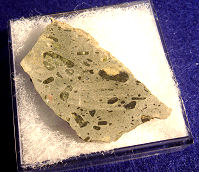 |
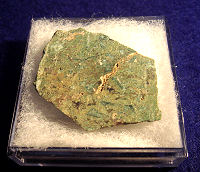 |
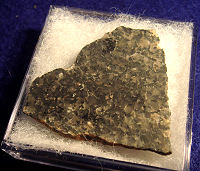 |
| Kimberlite, Bellshank mine, SA, in acrylic case | Walgidee pegmatite, Australia, in acrylic case | Titanite ijolite, British Columbia, in acrylic case |
Questions on any specimens? lab@petrologyslides.com |
| . |
 |
 Kimberlite, with macrocrystals in thin section |
 Kimberlite, with macrocrystals |
| Kimberlite, DeBeer's Premier Mine, South Africa, with macrocrystals |  Kimberlite, with macrocrystals, prepared slice. |
There is a stunning mix of
clasts within this sample of kimberlite from the DeBeers, Premier Mine, in
South Africa. The Premier Diamond Mine is geologically, the oldest known
kimberlite pipe. Every sample is diverse in its presentation. |
|
| Specimen# 61-9 | |
 |
 Aegirine syenite in thin section |
 Aegirine syenite |
| Aegirine syenite, Shawa, Zimbabwe |  Aegirine syenite |
Syenites are named for the city
of Syene, Egypt, where many ancient monuments are made of this (mostly)
light-colored stone. They're formed intrusively from alkaline igneous activity,
generally in thick continental crustal areas, or in Cordilleran subduction
zones and usually have large crystals from slow underground cooling. They are
not common rocks, usually peralkaline and peraluminous, with high proportions
of alkali elements and aluminium. This is an attractive rock with
brownish-green inclusions of Aegirine from Shawa, Zimbabwe. |
|
| Specimen# 62-117 | |
 |
 Eclogite, Marin Co., California in thin section |
 Eclogite, Marin Co., California |
| Eclogite, Tiberon, Marin Co., California |  Eclogite, Marin Co., California |
Eclogites are dramatic,
intense-looking rocks from the Earth's upper mantle. This is a great one from
Marin County, California with lots of amber colored garnet throughout. They are
of special interest because they form at pressures greater than those typical
of the crust of the Earth and being an unusually dense rock, eclogites play an
important role in driving convection within the upper mantle. This fresh rock
is striking in appearance, with orange garnet in a green matrix of sodium-rich
pyroxene (omphacite). Accessory minerals include kyanite, rutile, quartz,
lawsonite, coesite, amphibole, phengite, paragonite, zoisite, dolomite,
corundum, and, sometimes, diamond!. |
|
| Specimen# 63-130 | |
 |
 Pyroclastic Kimberlite, Canada,. in thin section |
 Pyroclastic Kimberlite, Canada |
| Pyroclastic Kimberlite, Lac de Gras Province, NWT, Canada |  Pyroclastic Kimberlite, Canada |
Pyroclastic rocks are formed by explosive eruption of lava and any rocks which are entrained within the eruptive column. This may include rocks pulled off the wall of the magma conduit, or physically picked up by the ensuing pyroclastic surge. The resulting rock is a volcanic breccia. All specimens of pyroclastic kimberlite are best seen in prepared slices. They are all clast-filled and different with both angular and rounded clasts well consolidated into the matrix and visually intense in thin section.These samples are from the Lac de Gras Province, NWT, Canada.
|
|
| Specimen# 64-127 | |
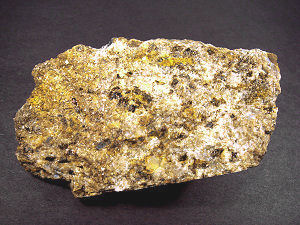 |
 Carbonatite with zirconolite and calzirtite |
 Carbonatite with zirconolite and calzirtite |
| Carbonatite with zirconolite and calzirtite, Kaiserstuhl Volcano, Germany |  Carbonatite with zirconolite and calzirtite |
This is a porphyritic
carbonatite dyke rock from the Kaiserstuhl, the largest volcanic center in the
Rhine Graben. There's a lot of great mineralogy in this one. Phonolites and
extrusive carbonatites are present along with Mn-rich olivine, pyrochlore,
Nb-rich perovskite, baddelyite, and the rare minerals zirconolite and
calzirtite as Nb-rich varities with REE! |
|
| Specimen# 65-83 |
|
 |
 Spinel Lherzolite xenolith in thin section |
 Spinel Lherzolite xenolith |
| Spinel Lherzolite xenolith, Lambert-Amery Rift System, East Antarctica |  Spinel Lherzolite xenolith |
This specimen is from the
Yuzhnoe multi-phase, intrusive body (late Jurassic, 145 Ma), of the
Lambert-Amery Rift System (Jetty Peninsula, East Antarctica. It is a slightly
serpentized rock delivered from the upper mantle by the host magma. It consists
of forsterite, enstatite, chrome-diopside, and chrome-spinel. Sulfide and
primary mantle carbonate are present as accessory minerals. A very rare
locality! |
|
| Specimen# 66-123 | |
 |

|
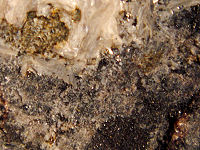 .Corundum with Margarite and Hematite |
| Corundum with Margarite and Hematite, Naxos, Cycladic Islands, Greece |  .Corundum with Margarite and Hematite |
This is hematite-laced corundum
with veins of margarite! It was collected from the amphibolite facies emery
deposits of Naxos, Greece, famed from antiquity. A very, very hard rock to cut
and prepare from a locality steeped in history! |
|
| Specimen# 67-124 | |
 |
 Ayer's Rock, Australia in thin section |
 .Ayer's Rock, Australia |
| Ayer's Rock, Australia |  .Ayer's Rock, Australia |
Ayer's Rock is the largest,
single, consolidated "rock" known in the world. It is dominantly
composed of coarse-grained arkose, a type of sandstone characterized by an
abundance of feldspar, and some conglomerate. Average composition is 50%
feldspar, 25-35% quartz and up to 25% rock fragments that include subrounded
basalts. Also known as "Uluru", Ayer's Rock is a sacred site for the
Aborigine people. They maintain all rights over the site, forbidding climbing
and sampling. These samples were acquired during the 1950's for research by an
Australian prospector. Samples of Ayer's rock are almost impossible to obtain
now. |
|
| Specimen# 68-113 | |
 |
 Kimberlite, green hypabyssal rock, Central Montana, in thin section |
 .Kimberlite, Central Montana |
| Kimberlite, Green Hypabyssal rock, Central Montana |  .Kimberlite, Central Montana |
This is Homestead Kimberlite
from Central Montana. It's classified as a
phlogopite-monitcellite-diopside-calcite-serpentine kimberlite. It's a great
looking green mantle xenolith! |
|
| Specimen# 69-110 | |
 |
 Eclogite Omphacite, Bravaria, Germany in thin section |
 Eclogite Omphacite, Bravaria, Germany |
| Eclogite Omphacite, Bravaria, Germany |  Eclogite Omphacite, Bravaria, Germany |
Omphacite (the greenish matrix)
is a major mineral component of eclogite (along with pyrope garnet). It also
occurs in eclogite xenoliths from kimberlite as well as in crustal rocks
metamorphosed at high pressures. Another great eclogite, this one is from the
Münchberg Metamorphic complex, Franconia, Bavaria, Germany Bravaria,
Germany. |
|
| Specimen# 70-115 | |
 |
 Komatite basalt, Barberton Greenstone Belt in thin section |
 Komatite basalt, Barberton Greenstone Belt |
| Komatite basalt, Barberton Greenstone Belt, South Africa |  Komatite basalt, Barberton Greenstone Belt |
Named from their type locality
along the Komati River in South Africa, komatiites are very rare. They're
ultramafic volcanic rocks, having very low silica contents (~40-45%) and very
high MgO contents (~18%). These lavas are exceptional not only for their
compositions, but also for their very old, restricted ages. They have no modern
analogs. From the Barberton Greenstone Belt in South Africa, komatiites are
about three billion years old or older. These ancient lava flows erupted at a
time when the Earth's internal heat was much greater than today, thus
generating exceptionally hot, fluid lavas with calculated eruption temperatures
in excess of 1,600 degrees C (2,900 degrees F). In comparison, typical basaltic
lavas erupting today have eruption temperatures of about 1,100 degrees C. |
|
| Specimen# 71-119 | |
 |
 Spitzbergen Basalt in thin section |
 Spitzbergen Basalt |
| Spitzbergen Basalt, Norway |  Spitzbergen Basalt |
Mantle xenoliths and their host
basalts from the Spitsbergen archipelago (Norway) contain chemically zoned
globules and patches of ankerite - magnesite carbonate minerals that are
similar to the carbonate minerals of the very famous Martian meteorite ALH
84001. These carbonate globules may help shed light on the origin of the ALH
84001 carbonates. A difficulty in understanding the martian carbonate minerals
has been the lack of comparable terrestrial occurrences for comparison. We now
have, in the Spitzbergen basalts, a terrestrial analog that may help us
understand the carbonate globules in this martian meteorite which is believed
to contain evidence for relic biogenic activity from the martian surface. |
|
| Specimen# 72-135 | |
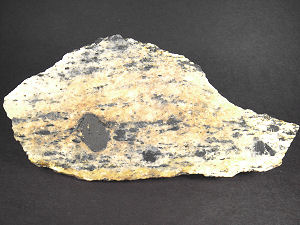 |

|
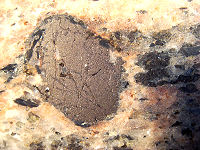 Carbonatite, olivine-phlogopite-dolomite |
| Carbonatite, olivine-phlogopite-dolomite, Mt Lempriere, BC, Canada | 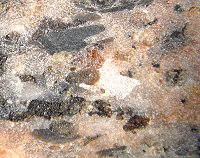 Carbonatite, olivine-phlogopite-dolomite |
This is a rarity: a Proterozoic
carbonate deformed in the Mesozoic with its primary mineralogy completely
preserved - phlogopite, fresh olivine. Also present in thin section, dolomite,
apatite, zircon, and pyrochlore. |
|
| Specimen# 73-84 | |
 |
 Bellshank Mine kimberlite in thin section. |
 Kimberlite, Bellshank Mine, texture. |
| Kimberlite, Bellshank Mine , Northern Cape, South Africa |  Bellshank Mine Kimberlite |
A very attractive kimberlite,
locally referred to as "blue ground" from it's bluish-tinged matrix,
kimberlites from the Bellshank Diamond mine are rarely available. Diamonds were
originally found in weathered kimberlite which was colored yellow by limonite,
and so was called yellow ground. Deeper workings encountered less altered rock,
serpentinized kimberlite, which miners call blue ground. Lots of xenoliths in
this one. |
|
| Specimen# 74-136 | |
 |
 Lherzolite mantle rock in thin section |
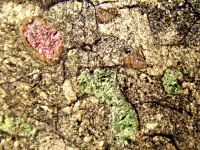 Lherzolite mantle rock |
| Lherzolite mantle rock, Kimberley, South Africa |  Lherzolite mantle rock |
This is a beautiful garnet
bearing Lherzolite mantle rock from more than 200 kilometers down, rich in
chrome-diopside. It's a coarse grained, ultramafic, igneous rock that,
excepting eclogites are probably the most attractive samples of the Earth's
upper mantle that we have. |
|
| Specimen# 75-67 | |
 |
 Kimberlite, Crater of Diamonds Mine, Arkansas in thin section |
 Kimberlite, Crater of Diamonds Mine, Arkansas |
| Kimberlite, Crater of Diamonds Mine, Arkansas | 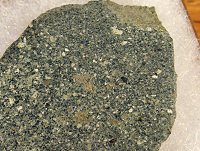 Kimberlite, Crater of Diamonds Mine, Arkansas |
Crater of Diamonds, located
southeast of Murfreesboro in Pike County, Arkansas, has a rich 100-year history
of diamond mining. The kimberlite pipe is the eighth largest diamond-bearing
deposit in the world and the average weight of Crater diamonds is about
0.2-carats. This kimberlite is greenish with abundant, small clasts and
inclusions. |
|
| Specimen# 76-63 | |
 |
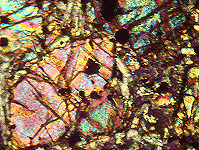 Dunite, Western Gneisses, Norway in thin section |
 Dunite, Western Gneisses, Norway |
| Dunite, Western Gneisses, Norway |  Dunite, Western Gneisses, Norway |
Comprised of greater than 90%
olivine, with minor pyroxenes and chromite, dunites are olivine-rich
end-members of the peridotite group of mantle-derived rocks. They are
coarse-grained, plutonic igneous rocks of ultramafic composition. Dunites from
the Western Gneisses region are very old, brought to the surface thru ophiolite
obduction |
|
| Specimen# 77-104 | |
 |

|
 Carbonatite |
| Carbonatite, Columbium Rare Metals Mine, Oka, Quebec, Canada | 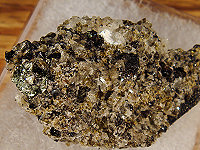 Carbonatite, Oka, Quebec |
The majority of carbonatites are
Proterozoic or Phanerozoic in age. They are rare, peculiar igneous rocks formed
by unusual processes and from unusual source rocks. The primary mineral content
is highly variable, but it may include natrolite, sodalite, sovite, apatite,
magnetite, barite, fluorite, ancylite group minerals, and other rare minerals
not found in more "normal" igneous rocks. Recognition of these exotic
rocks is also difficult, especially as their mineralogy and texture may not
differ much from marble. This one, from Oka, Quebec is the most attractive
carbonatite in our collection. |
|
| Specimen# 78-96 | |
 |

|
 Alkali olivine basalt, Lenderut, Kenya |
| Alkali olivine basalt, Lenderut, Kenya | 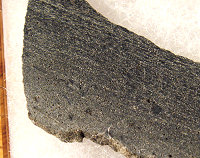 Alkali olivine basalt, Lenderut, Kenya |
Alkali basalts are relatively
poor in silica and rich in sodium. They are silica-undersaturated and may
contain feldspathoids, alkali feldspar and phlogopite and typically have
mineral assemblages that lack orthopyroxene. Typically they're fine-grained,
dark-colored, volcanic rocks characterized by phenocrysts of olivine,
titanium-rich augite, plagioclase feldspar and iron oxide. |
|
| Specimen# 79-85 | |
 |
 Carbonatite, olivine magnetite megacrysts in thin section |
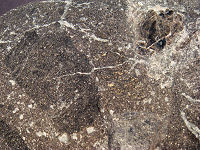 Carbonatite, olivine magnetite megacrysts |
| Carbonatite, olivine magnetite megacrysts, Cataldo Carbonatite I complex, Cataldo Mine, Brazil | 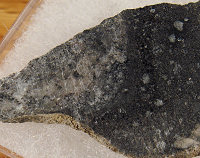 Carbonatite, olivine magnetite megacrysts |
Here's a carbonatite with tons
of olivine magnetite xenoliths both large and smal in a bizarre groundmass of
nephelinite and glimmerite from the Cataldo Carbonatite I complex. |
|
| Specimen# 80-38 | |
On-Line Catalog Page 4
| 1 | 2 | 3 | 4 | 5 | 6 | 7 | 8 |